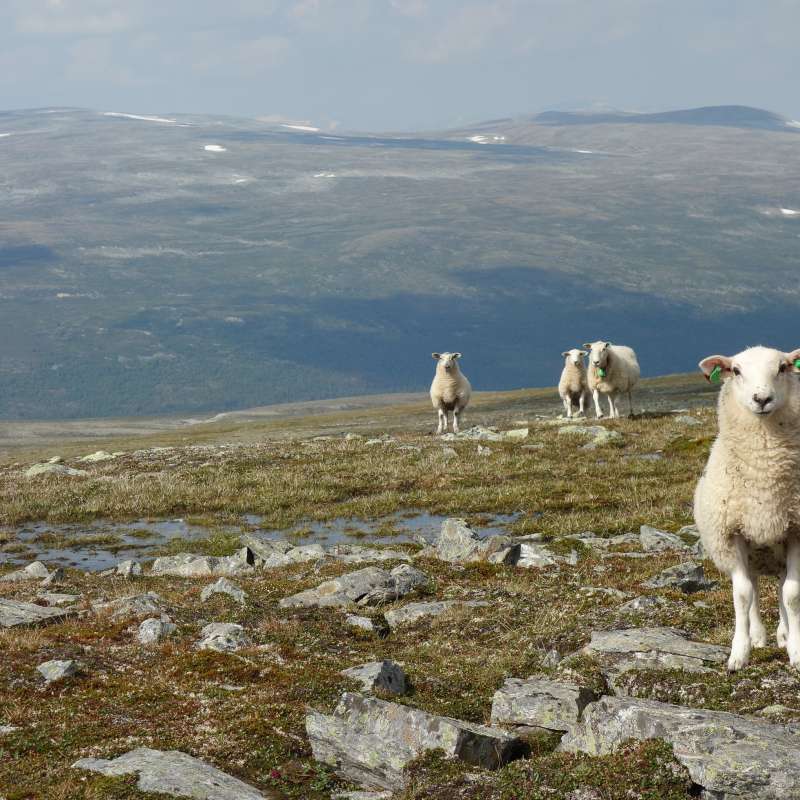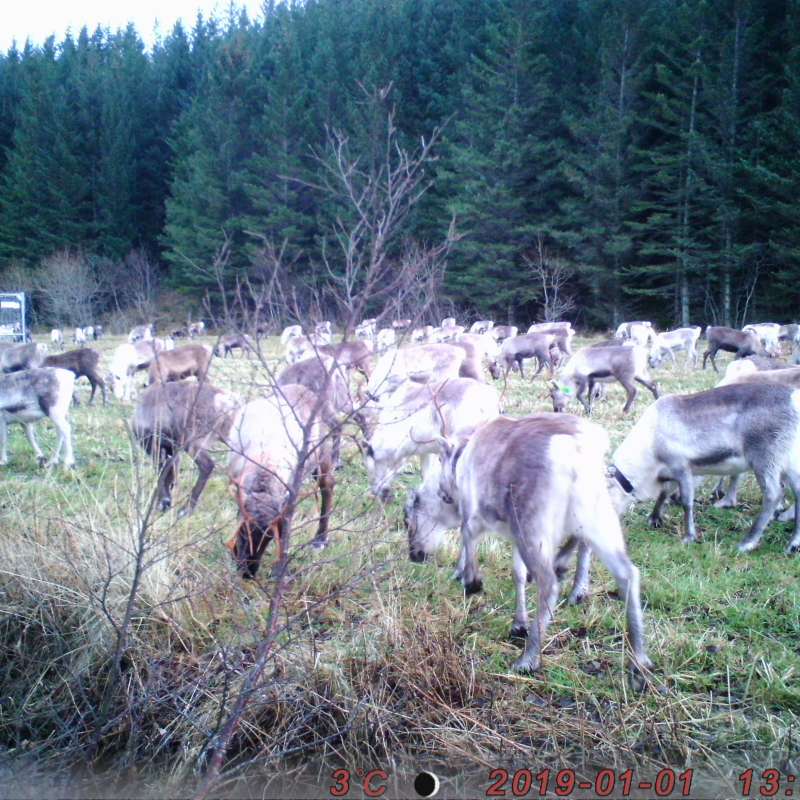Inger Hansen
Seniorforsker
Biografi
Sammendrag
Det er ikke registrert sammendrag
Forfattere
Gabriela Wagner Inger Hansen Svein Eilertsen Erling Meisingset Grete H. M. Jørgensen Erlend Winje Tor-Arne BjørnSammendrag
Det er ikke registrert sammendrag
Sammendrag
Increasing populations of large carnivores are leading to tension and conflicts with livestock production, a situation that potentially might escalate. In Norway the objective of the large carnivore policy is two-folded: to ensure viable carnivore populations and to secure a sustainable grazing industry. The main instrument is zonation, with carnivore management zones (CMZs) prioritized for reproduction of the large carnivore species separated from other areas prioritized for grazing livestock. The objective of this paper is to describe current knowledge about the impact of the zoning management strategy on the grazing industry. This is done by documenting status and changes in sheep production, losses of livestock to predating carnivores, and the use of grazing areas inside and outside the CMZs. CMZs offering protection for lynx, wolverine, bear and wolf cover 55% of the Norwegian mainland. 30% of the sheep and 50% of the Sami reindeer grazing areas are found inside the CMZs. Livestock (semi-domestic reindeer excluded) is using 59% of the available natural pasture areas outside the CMZs, but only 26% inside the CMZs. The lowest use of available grazing areas was found inside zones for wolves (12%) and brown bears (6%). Livestock in these zones are confined to fenced enclosures, mostly on the farm itself, or moved to pastures outside the management zone for summer grazing. Livestock losses increased in the affected regions during the period when carnivores were reestablished. Later, losses declined when CMZs were established and mitigation efforts were implemented in these zones. The bulk of sheep and reindeer killed by carnivores are now found in boundary areas within 50 km off the CMZs, where sheep are still grazing on open mountain and forest ranges. Therefore, instruments to protect livestock in areas close to the CMZs are also needed. The number of sheep declined inside the CMZs from 1999 to 2014, but increased outside the zones. The reduction in the absolute number of sheep in the CMZs is balanced by a similar increase outside, thus the total sheep production in Norway is maintained. We conclude that although of little consequence for the total food production in Norway, the economic and social impact of the large carnivore management strategy can be serious for local communities and individual farmers who are affected. There is a need for more exact carnivore population monitoring to quantify the carnivore pressure, better documentation of reindeer losses, and a clearer and stricter practicing of the zoning strategy. Increased involvement of social sciences is important in order to understand the human dimension of the carnivore conflicts.
Forfattere
Seyda Özkan_Gülzari Grete H. M. Jørgensen Svein Eilertsen Inger Hansen Snorre Hagen Ida Marie Luna Fløystad Rupert PalmeSammendrag
Several non-invasive methods for assessing stress responses have been developed and validated for many animal species. Due to species-specific differences in metabolism and excretion of stress hormones, methods should be validated for each species. The aim of this study was to conduct a physiological validation of an 11-oxoaetiocholanolone enzyme immunoassay (EIA) for measuring faecal cortisol metabolites (FCMs) in male reindeer by administration of adrenocorticotrophic hormone (ACTH; intramuscular, 0.25 mg per animal). A total of 317 samples were collected from eight male reindeer over a 44 h period at Tverrvatnet in Norway in mid-winter. In addition, 114 samples were collected from a group of reindeer during normal handling and calf marking at Stjernevatn in Norway. Following ACTH injection, FCM levels (median and range) were 568 (268–2415) ng/g after two hours, 2718 (414–8550) ng/g after seven hours and 918 (500–6931) ng/g after 24 h. Levels were significantly higher from seven hours onwards compared to earlier hours (p < 0.001). The FCM levels at Stjernevatn were significantly (p < 0.001) different before (samples collected zero to two hours; median: 479 ng/g) and after calf marking (eight to ten hours; median: 1469 ng/g). Identification of the faecal samples belonging to individual animals was conducted using DNA analysis across time. This study reports a successful validation of a non-invasive technique for measuring stress in reindeer, which can be applied in future studies in the fields of biology, ethology, ecology, animal conservation and welfare.
Forfattere
Grete H. M. Jørgensen Svein Eilertsen Cecilie Marie Mejdell Solveig Marie Stubsjøen Inger HansenSammendrag
Det er ikke registrert sammendrag
Forfattere
Inger Hansen Svein Eilertsen Ole Jakob Sørensen Torill Mørk Kari Anne Bråthen Bernt Johansen Pål Fossland Moa Camilla Risvoll Camilla Sandström Erlend WinjeSammendrag
Source at <ahref=http://hdl.handle.net/11250/2644088>http://hdl.handle.net/11250/2644088</a>
Sammendrag
Det er ikke registrert sammendrag
Forfattere
Inger HansenSammendrag
Det er ikke registrert sammendrag
Sammendrag
Det er ikke registrert sammendrag
Sammendrag
Det er ikke registrert sammendrag
Sammendrag
Det er ikke registrert sammendrag
Sammendrag
Det er ikke registrert sammendrag
Forfattere
Inger HansenSammendrag
This literature review documents behavioural differences in organic and conventional sheep and goats in Norway. Increased indoor space results in increased lying time, more synchronized lying behaviour, less displacements and higher milk yield in sheep, and increased lying time and lower frequency of agonistic behaviour in goats. Sheep and goats spend 45-50 % of their time outdoors when given access to an outdoor yard during winter. Under normal thermal conditions, fully fleeced sheep do not need solid floors of welfare reasons in Norway. Neither do dairy goats in insulated buildings. The significance of different milk feeding strategies in goat kids is poorly documented, but studies on lambs and calves show that suckling increases the growth rate, gives better social competence and more exploratory behaviour. Thus, the organic regulations in Norwegian sheep and goat production have some positive impact on behavioural indicators of sheep and goat welfare, especially during winter housing.
Sammendrag
Det er ikke registrert sammendrag
Forfattere
John Durrus Linnell Ole-Gunnar Støen Inger Hansen Svein Eilertsen Øystein Flagstad Vincenzo Gervasi Henrik Brøseth Jon Swenson John OddenSammendrag
-
Forfattere
Inger HansenSammendrag
Det er ikke registrert sammendrag
Sammendrag
Det er ikke registrert sammendrag
Sammendrag
Det er ikke registrert sammendrag
Sammendrag
Det er ikke registrert sammendrag
Sammendrag
Det er ikke registrert sammendrag
Sammendrag
Det er ikke registrert sammendrag
Sammendrag
Det er ikke registrert sammendrag
Forfattere
Inger HansenSammendrag
Vokterhundprinsippet baserer seg på en gjensidig sosial binding mellom hund og sau. Sosialiseringsmetoden er avhengig av bruksmåte og jo mer selvstendig hunden skal jobbe i lag med sau, dess sterkere sosial binding til sau kreves. Under norske forhold må imidlertid vokterhunder sosialiseres tilstrekkelig på mennesker.
Sammendrag
Vokterhunder benyttes i dag i flere land som forebyggende tiltak mot rovviltskader. Tiltaket har generelt vist en sterk tapsreduserende effekt. De fleste bruksmåter i utlandet er basert på at vokterhunden sosialiseres på sau i tidlig valpealder. Hunden vil dermed oppfatte sauene som sine flokkmedlemmer som den vil forsvarer mot rovvilt. Et effektivt forsvar forutsetter imidlertid at sauene går i flokk. Det norske saueholdet er karakterisert ved at sauene beiter spredt på store utmarksarealer. For at bruk av vokterhund skal kunne bli et effektivt tiltak i Norge, må derfor sauene samles, enten ved gjeting eller ved bruk av inngjerdede beiter. Alternativt kan man finne nye måter å bruke vokterhund på som er bedre tilpasset det tradisjonelle norske saueholdet. Av de sju ulike bruksmåter for vokterhund som er beskrevet, anbefales to metoder under norske forhold: vokterhunder på patrulje og vokterhunder på inngjerdet beite. Den første metoden krever ikke at sauene går i flokk og er dermed tilpasset det norske beitebruket. Den sistnevnte metoden krever en omlegging av beitedrifta, men har imidlertid vist seg å ha bedre tapsforebyggende effekt. Den forebyggende effekt er diskutert opp mot tiltakets kostnader og ulemper, som arbeidsinnsats, reduserte slaktevekter, gjerdehold og et utvidet innmarksbruk. Ulike bruksmåter krever ulik styrke av sosialisering mellom hund og sau. En beskrivelse over sosialiseringsopplegget i forhold til bruksmåte er gitt. I tillegg gir veilederen også nyttige tips om rasevalg, valg av valp og dressur.
Forfattere
Inger HansenSammendrag
Det er ikke registrert sammendrag
Sammendrag
Det er ikke registrert sammendrag
Sammendrag
Det er ikke registrert sammendrag
Sammendrag
Nord-Norge har svært gode utmarksbeiter, men de utnyttes i mindre grad. Hvorfor? Vi spurte 15 bønder i regionen og fikk svar: Det handler om motivasjon for å fortsette med beitebaserte produksjoner.

Divisjon for skog og utmark
Jerv som predator på småfe i Nord-Gudbrandsdalen
I dette prosjektet skal vi dokumentere jervens rolle som skadevolder på sau, og identifisere effektive tiltak for å forebygge slike tap. Prosjektet gjennomføres i fem kommuner i Nord-Gudbrandsdalen som har hatt store tap til jerv. Funn og metoder herfra vil ha overføringsverdi til andre deler av landet.

Divisjon for skog og utmark
Reinbeiting på dyrka mark
Intensiv beiting av husdyr påvirker avling og plantenes opplagsnæring, og har negativ effekt på overvintringsevne og spiringsegenskapene om våren. Avlingsreduksjonen er avhengig av beitetidspunkt, nedbeitingsgrad, artssammensetning i enga, samt lokalt klima og værforhold det aktuelle året mm. Det er få presise og omfattende studier på avlingstap grunnet graveskader og beiting av rein på innmark.
